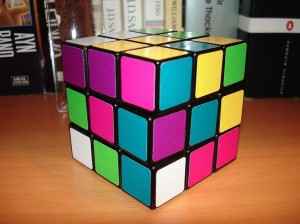 The 2012 World Cube Association’s U.S. National Championship was held at the beginning of August in Las Vegas. A California teenager, Deven Nadudvari, set a record by using one hand to solve 5 different 3-by-3 Rubik’s Cubes in an average of 14.86 seconds each.
The 2012 World Cube Association’s U.S. National Championship was held at the beginning of August in Las Vegas. A California teenager, Deven Nadudvari, set a record by using one hand to solve 5 different 3-by-3 Rubik’s Cubes in an average of 14.86 seconds each.
“You can use Rubik’s Cube to teach engineering, you can use it to teach mathematics, and you can use it to talk about the interplay between design and engineering and mathematics and creativity,“ according to Paul Hoffman, president of the Liberty Science Center in Jersey City, who is organizing an international exhibition in 2014 that will celebrate the cube’s 40th anniversary. (Montreal Gazette, 8/11/2012, Quenqua)
The Rubik’s Cube has been used to teach Group Theory in mathematics. For more information about group theory and the cube, check out any of these books.
Photo from allie
